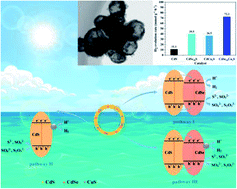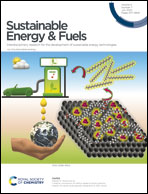One-step synthesis of CdS/CdSe/CuS hollow nanospheres in aqueous solution for enhanced photocatalytic hydrogen evolution†
Abstract
In this work, a new kind of CdS/CdSe/CuS hollow nanospheres (HNPs) is successfully synthesized by one-step synthesis via vulcanization and selenization in aqueous solution, without using any additional templates, for the first time. The three components of CdS, CdSe and CuS in the HNPs are thoroughly combinated with each other at nano-scale, which creates a large quantity of intimate contact interfaces. As a result, the optimal CdSe30Cu2S HNPs exhibit an excellent photocatalytic H2 evolution rate of 723 μmol h−1 (10 mg of catalyst) without adding any noble metal co-catalysts, which is 6.5 times higher than that of the pristine CdS HNPs. The hollow structure enhances the light absorption and provides the inner surface as active sites for the infiltrated water to receive the inner-shell electrons quickly for H2 evolution and the CdS/CdSe/CuS heterostructure with CuS acting as the co-catalyst forms three charge transfer pathways to promote the separation and migration of the photo-induced electrons and holes, resulting in the enhanced photocatalytic performance. This work may provide a strategy for the design and synthesis of other photocatalysts for highly efficient H2 evolution.



 Please wait while we load your content...
Please wait while we load your content...